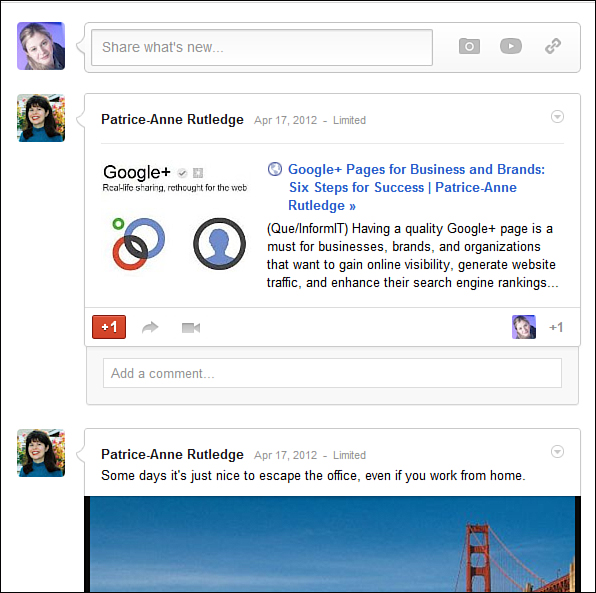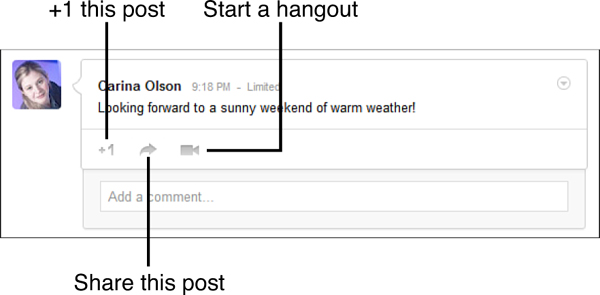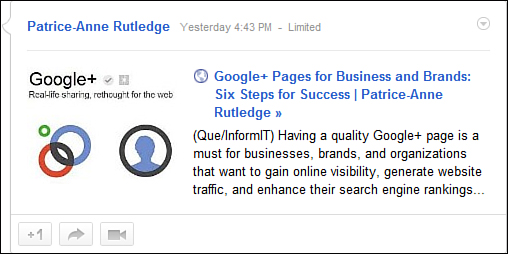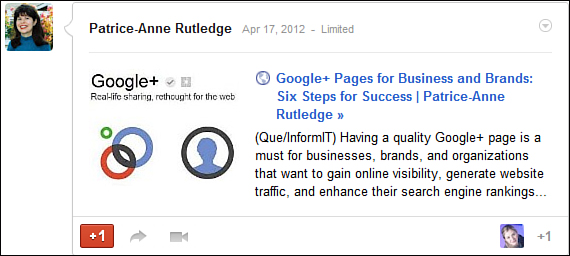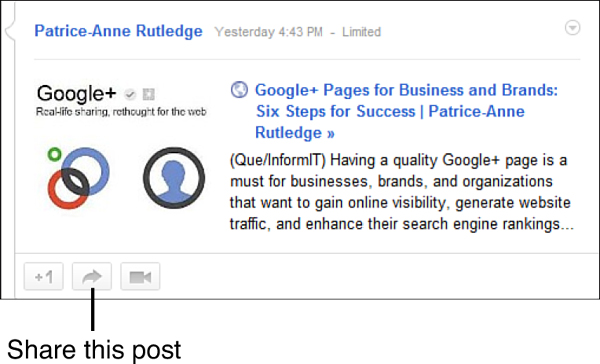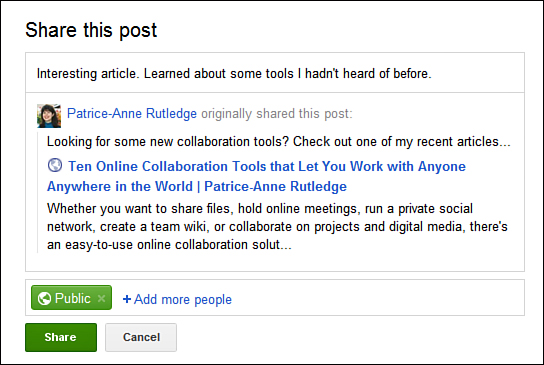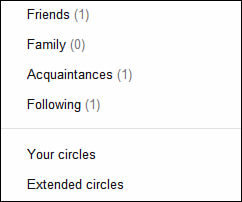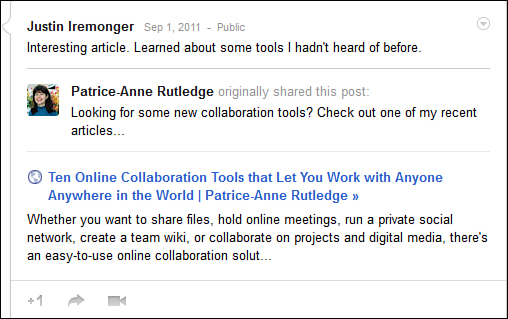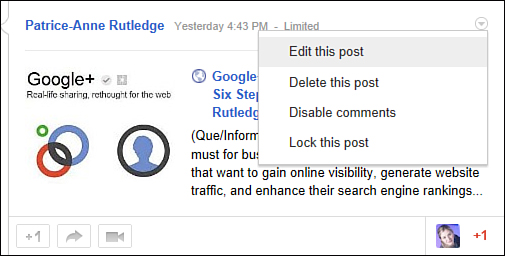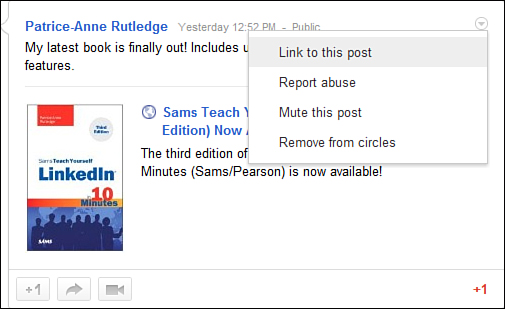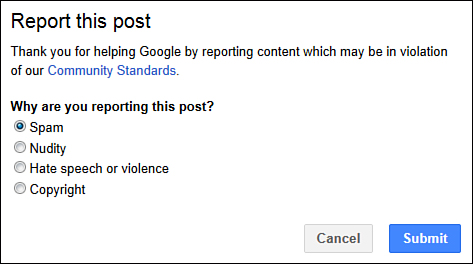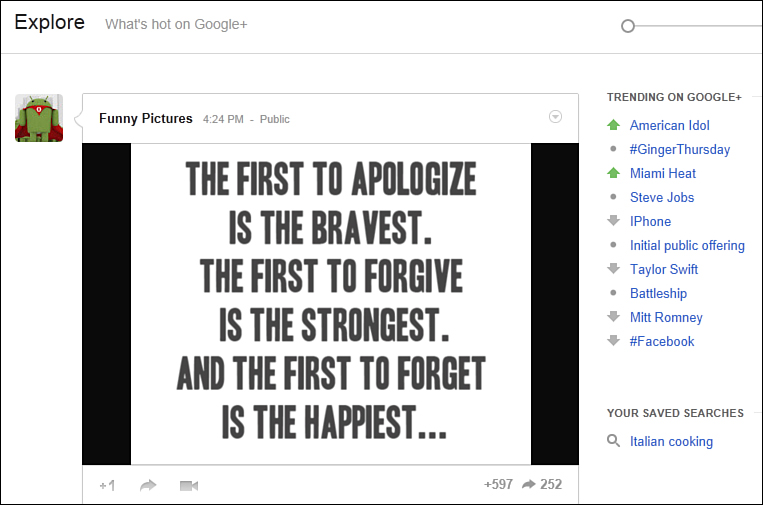Lesson 7. Viewing Your Google+ Stream
In this lesson, you learn how to view, manage, and participate in your Google+ stream.
Exploring Your Stream
On Google+, the center of activity is your stream. This is the first page you see when you sign into Google+ and the place where you’ll spend the majority of your time on the site.
The Google+ stream offers a central location for viewing the posts, links, photos, and videos that you and others have shared. You can join the conversation on the stream by adding your own posts and comments, sharing interesting content you discover, and supporting quality posts using the Google +1 button.
Your Google+ stream, shown in Figure 7.1, displays the posts submitted by people in your circles, your posts, and selected Hot on Google+ posts (trending content across Google+ that Google deems particularly interesting or informative). See “Viewing the Explore Page” later in this lesson to learn more about Hot on Google+ posts and how you can control how many of them display in your stream.
Figure 7.1. Your stream is the center of activity on Google+.
If you have only a few people in your circles, Google+ displays the Not Enough People in Your Stream? section, which helps you find more people to add.
Accessing Your Stream
Your Google+ stream isn’t hard to find. It’s the first page you see when you sign into Google+. If you go to another location on Google+, you can return to your stream by clicking the Home icon on the Google+ ribbon.
Viewing a Sample Post
Figure 7.2 shows a sample Google+ post shared by someone in one of your circles.
Figure 7.2. Viewing a basic post in your Google+ stream.
For each post, you can do the following:
• Pause your mouse over someone’s name to view a pop-up with more information about this person.
• Click someone’s name to view this person’s Google+ profile.
• Click the date to view other posts from that date.
• Click the Limited link to view gravatars of people the post author shared with. The Limited link displays only when the author shared this content with specific circles rather than publicly. If the Public link displays instead, the author shared the content publicly and it’s visible to anyone on the Web.
• Click the +1 This Post button to show your support for this post using Google +1. See “Liking a Post Using the +1 Button” later in this lesson for more information.
• Click the Share This Post button to share this post with others. See “Sharing Posts” later in this lesson for more information.
• Click the Start a Hangout About This Post button to start a hangout with the post author. See Lesson 12, “Using Hangouts for Video Chat,” to learn more about hangouts.
• Click the Add a Comment box to add a comment. See “Commenting on Posts” later in this lesson for more information.
Depending on the actions of the original author and the people reading the post, other content might be available. Figure 7.3 shows a post with additional content and conversation.
Figure 7.3. Viewing a post with lots of conversation.
When a post contains additional content or activity, other options for interaction become available. For example, you can
• Click a link to view content from an external site, such as a blog post that someone shared on Google+.
• Click an attached photo to enlarge it or add tags to it. See Lesson 10, “Working with Photos,” for more information about tagging photos.
• Click a video to play it in Google+.
• Pause your mouse over the name of someone mentioned in a post to view a pop-up box with more information about this person. Optionally, click the person’s name to view this person’s profile. Google+ identifies a mention by placing the plus sign (+) before someone’s name, such as +Anne Smith.
• View the number of +1’s. Click the +[number] link to view a complete list of people who shared. For example, if 8 people shared this post, the link name would be +8.
• View the number of shares, including the names of some people who shared this post. Click the [Number] Shares link to view a complete list of people who shared. For example, if 12 people shared this post, the link name would be 12 Shares.
• View the most recent comments at the end of a post. To view additional comments, click the [Number] Comments link. Click the Expand This Comment link to view the entire text of longer comments. You can also add your own comment to an existing comment. See “Commenting on Posts” later in this lesson for more information.
Be aware that all of these options might not be available for every post. For example, not all posts contain links, videos, photos, mentions, comments, shares, and +1’s.
Filtering Your Stream
By default, Google+ displays both your posts and the posts of people in your circles on your stream. If you have a large network with many circles, however, your stream can become overloaded with too much content.
To filter your stream, click the name of a circle above the share box (see Figure 7.4). By default, the Friends and Family circles display here. To access other circles, click the More button and select a circle from the drop-down menu.
Figure 7.4. You can filter your stream by circle.
Google+ displays only the posts from the people in this circle. For example, if you click the Friends button, your stream displays only posts from people in this circle.
If you want to view only your own posts, click the Profile icon on the Google+ ribbon. All your posts display on the Posts tab of your profile.
Note: Why Did My Content Disappear When I Applied a Filter?
Be aware that if no one in a circle has posted on Google+, you won’t see any content when you filter to that circle. This is particularly common if you have only a few people in a circle and they are new to Google+.
Tip: Google+ Displays Game-Related Posts on the Games Stream
If you enjoy playing games, Google+ displays all posts related to your gaming activities on the Games stream and not on the main Google+ stream. This way, only your game buddies need to know about your high score on Bejeweled Blitz or your other game achievements. See Lesson 13, “Playing Games,” for more information about Google+ games and the Games stream.
Participating in the Stream
After you’ve spent some time reading posts in your stream, you’ll probably want to join the conversation and start adding your own commentary. Google+ gives you the option to show your support for a post with +1, add a comment to a post, or share a post.
Liking a Post Using the +1 Button
One of the fastest and easiest ways to let people know that you like specific content in your Google+ stream is to use the +1 button.
Plain English: Google +1 Button
The Google +1 button offers a way to publicly show your support for a post that you like. The +1 button is available on Google+ and, optionally, on other websites and blogs that choose to enable this button. Google+ uses the term “+1” as both a noun and verb. In other words, you +1 a post using the +1 button. To learn more about the concept behind the Google +1 button, visit www.google.com/+1/button.
If you want to show others that you like a post in your stream, click the +1 button that displays below the post content (see Figure 7.5).
Figure 7.5. Click the +1 button to show your support for a post.
Your stream shows that you +1’d the post (see Figure 7.6). Be aware that this action is public and others can also see that you +1’d the post.
Figure 7.6. You can see the posts you +1’d in your stream.
If you clicked the +1 button by mistake, click it again (it’s now red) to undo your +1.
Tip: Show Your Support for a Comment Using the +1 Button
Using the +1 button isn’t reserved for posts; you can use it to support comments as well. If you want to show your support for a particularly interesting or insightful comment, pause your mouse over it and click the +1 button to its right.
Commenting on Posts
If you have something to say about a post, you can add your own commentary.
To add a comment, follow these steps:
1. Click the Add a Comment link at the bottom of the post you want to comment on.
2. Type your comment in the text box that displays (see Figure 7.7).
Figure 7.7. Join the conversation on Google+ by adding your own comments.
3. Click the Post Comment button to post your comment. Figure 7.8 shows a sample published comment.
Figure 7.8. Your comment displays at the end of a post.
Tip: Apply Styles and Mention People in a Comment
Just like with a post, you can apply styles such as bolding and italics to your comment text. You can also mention other Google+ users and include a link to their profiles. See Lesson 6, “Sharing Content on Google+,” for more information about applying styles and mentioning other Google+ users.
Editing a Comment
After posting a comment, you might notice a typo or think of something else you want to add.
To edit a comment you wrote, follow these steps:
1. Click the Edit link to the right of the comment.
2. Make your changes in the text box.
3. Click the Save Changes button.
Google+ updates your comment with the changes you made.
Deleting a Comment
If you decide that posting your comment wasn’t such a good idea after all, you can delete it.
To delete a comment you wrote, click the Edit link to the right of the comment and then click the Delete Comment button.
Google+ permanently deletes your comment.
Sharing Posts
When you find an interesting post on Google+, you can share it with others. You can also share post comments.
To share a post, follow these steps:
1. Click the Share This Post button below the post you want to share, as shown in Figure 7.9.
Figure 7.9. Share interesting posts with others on Google+.
Caution: Consider Carefully Who You Share With
If the original author shared this post only with a limited audience (such as people in circles), Google+ reminds you of this fact and encourages you to use discretion when sharing. In general, it’s good etiquette to focus on sharing posts that others made public rather than only with those in their chosen circles.
2. In the Share This Post box, shown in Figure 7.10, add your own comments about the post in the text box.
Figure 7.10. Add your own comments to the content you share.
3. If the original author made this post public, Google+ makes your shared version public as well, visible to anyone on the Web. If you don’t want to share this post publicly, click the Delete icon (x) on the right side of the Public button. If the original author shared this post only with a limited audience, you can share it with your circles but not publicly.
4. To share this post with specific circles, click the Add More People link.
5. In the menu that opens (see Figure 7.11), select the circles you want to share with. If you want to share with all your circles, select Your Circles. If you want to share with your extended circles (friends of friends), select Extended Circles.
Figure 7.11. You can choose the specific circles you want to share with.
6. When you’re finished selecting circles, click outside the menu to close it.
7. If you want to send a notification and email about this post to the people in a circle, hover the mouse above that circle and select the Notify About This Post check box. In general, you should send notifications and emails only for very urgent or important posts.
8. If any of the people in your selected circles aren’t on Google+ yet, you have the option to send them an email about this post. To do so, click the Also Email [Number of] People Not Yet Using Google+ check box. To view the people who will receive this email, click the [Number of] People link. For example, if two people you added to circles haven’t signed up for Google+ yet, this link says “2 People.” Again, use caution when emailing people and send emails only for very important content.
9. Click the Share button to share your post with the people you selected.
Figure 7.12 shows a sample shared post, visible on the streams of the people you shared with as well as on your public profile if you selected to make this post public. Your Google+ network can comment on, share, or +1 any post you share.
Figure 7.12. A shared post that appears on your stream.
Note: Google+ Ripples Illustrates the Impact of Sharing
When you—or anyone else—shares a post, Google+ displays this action in graphic format through Google+ Ripples. To view a ripple diagram for a post that’s been shared, click the down arrow in the upper-right corner of the post and select View Ripples from the menu. A diagram opens that displays the people who shared the post and their connection to others who shared. Be aware that a ripple diagram displays data only for the past 53 days.
Managing Your Posts in the Stream
After you share posts to the Google+ stream, you might want to make a few changes. To manage a post you created, click the small down arrow in the upper-right corner of the post to open the Options menu. By selecting an option from this menu, you can edit a post, delete a post, report or remove comments, disable comments, or lock a post. This menu displays only for your own posts. See “Managing Your Circles’ Posts in the Stream” later in this lesson to learn about the menu options available for posts from people in your circles.
Tip: View All Your Posts on Your Profile
If you want to view only your own posts rather than the mixed assortment of posts that display on your stream, you can do so on the Posts tab of your profile. The Options menu is available there as well.
Editing a Post
For example, you can edit a post to fix a typo; to add a photo, video, or link you forgot to include; or delete something you regret posting.
To edit one of your posts, follow these steps:
1. Click the down arrow in the upper-right corner of your post to open the Options menu, as shown in Figure 7.13.
Figure 7.13. If you make a mistake, you can edit your post.
Caution: Post Edits Don’t Transfer to Shared Content
If someone shared your post before you edited it, the original version of the post will remain in any shared locations. If a post contains a serious error that needs to be changed, you must ask the people who shared to delete and share again.
Deleting a Post
To delete one of your posts, follow these steps:
1. Click the down arrow in the upper-right corner of your post.
2. Select Delete This Post from the Options menu (refer to Figure 7.13).
3. Click the Delete button in the dialog box that opens to confirm the deletion. Google+ permanently removes the post from your stream. You can no longer view this post nor can anyone you shared it with.
Caution: Deleting Doesn’t Remove Shared Posts
If someone shared your post before you deleted it, the shared version of the post will remain on Google+. To delete the shared versions of your posts, you must ask the people who shared to delete as well. If you don’t want people to be able to share a post, you should lock it. See “Locking a Post” later in this lesson for more information.
Disabling Comments
If you don’t want people to comment on a post, you can disable comments for it.
To disable comments for a post, click the down arrow in the upper-right corner of the post and select Disable Comments from the Options menu (refer to Figure 7.13).
Google+ removes the Add a Comment link at the bottom of the post but retains any existing comments. Optionally, you can also remove any existing comments. See “Reporting or Removing Comments” later in this lesson for more information.
If you want to enable comments again, click the down arrow in the upper-right corner of the post and select Enable Comments from the Options menu.
Locking a Post
If you want to prevent others from sharing a post, you can lock it.
To lock a post, click the down arrow in the upper-right corner of your post and select Lock This Post from the Options menu (refer to Figure 7.13). Google+ alerts you that people can no longer share this post and removes the Share link at the bottom of the post.
If you want to unlock a post, click the down arrow in the upper-right corner of the post and select Unlock This Post from the Options menu.
Reporting or Deleting Comments
If others have commented on your post, you can report or delete any comment.
Reporting a Comment
If someone posts an inappropriate comment in response to one of your posts, you can report it to Google.
Caution: Consider Carefully Which Comments to Report as Abuse
You can report comments that violate Google+ terms and conditions (spam, nudity, hate speech, violence, copyright abuse, or child abuse). If someone simply disagrees with your post, you can remove the comment. Comments with dissenting opinions don’t constitute abuse unless someone repeatedly posts comments to the point of harassment.
To report a comment, pause your mouse over it and click the Report Abuse or Block button (a small flag icon) to the right of the comment, as shown in Figure 7.14.
Figure 7.14. Click the flag icon to report abuse.
From here, you can pause your mouse over the Alert icon (grey triangle with an exclamation point) and click one of the following links:
• Remove, to remove the comment
• Restore, to restore the comment if you clicked the Report Abuse or Block button by mistake
• Remove and Block This Person, to remove the comment and block this person from commenting again
Google+ reviews all reports of abuse and takes appropriate action if necessary.
Deleting a Comment
If you find an inappropriate or annoying comment on one of your posts, you can delete it. To delete a comment, pause your mouse over it and click the Delete Comment button (x) to its right (refer to Figure 7.14).
In the pop-up box that opens, click one of the following buttons: Delete Comment and Block This Person or Delete. Google+ deletes the comment from your post.
When you block people, Google+ removes them from your circles and extended circles, and their posts no longer display on your stream. In addition, they can’t comment on your content posted after you blocked them or mention you in their posts or comments. Be aware, however, that blocked people can still view your public content on Google+ and can place you in their own circles.
Caution: Consider Other Options Before Blocking Someone
Blocking is a strong action that should be reserved for those people who are posting inappropriate content or are harassing you on Google+. You should consider other options before choosing to block someone. For example, you can remove people from your circles if you no longer want to view their content. Or, if you just don’t want to see a specific post anymore, you can mute it.
Managing Your Circles’ Posts in the Stream
Google+ also enables you to manage the content the people in your circles post. To manage a post of someone in one of your circles, click the small down arrow in the upper-right corner of the post to open the Options menu. By selecting an option from this menu, you can link to a post, report abuse, mute a post, or block the person who posted. This menu displays only for posts the people in your circles create. See “Managing Your Posts in the Stream” earlier in this lesson to learn about the menu options available for posts you create.
Linking to a Post
You can link to a public Google+ post from an external website or blog.
To link to a Google+ post, follow these steps:
1. Click the down arrow in the upper-right corner of the post (see Figure 7.15).
Figure 7.15. Select Link to This Post from the Options menu that opens.
2. Select Link to This Post from the Options menu. Google+ opens the Link to This Post dialog box (see Figure 7.16).
Figure 7.16. Copy the URL to link to it from your website or blog.
3. Copy and paste the URL on the site you want to include the link.
4. Click the OK button to close the Link to This Post dialog box.
Reporting Abuse
If someone posts content that violates Google’s terms and conditions, you can report it.
Caution: Consider Carefully When to Report Content as Abuse
You should report content only if it violates Google+ terms and conditions (spam, nudity, hate speech, violence, copyright, or child abuse). If someone simply posts content you don’t like, you should just mute a specific post or remove this person from your circles rather than filing an abuse report.
To report abuse, follow these steps:
1. Click the down arrow in the upper-right corner of the post.
2. Select Report Abuse from the Options menu (refer to Figure 7.15).
3. In the Report This Post dialog box, shown in Figure 7.17, select the reason for reporting abuse: Spam, Nudity, Hate Speech or Violence, or Copyright.
Figure 7.17. Let Google know why this post is abusive.
4. Click the Submit button to submit your report to Google. Google reviews all reports of abuse and takes any necessary action.
Tip: Removing Someone from Your Circles If You Don’t Like the Content This Person Posts
If someone posts content you don’t like but doesn’t constitute abuse, consider simply removing this person from your circles. To do so, click the down arrow in the upper-right corner of the post and select Remove from Circles from the Options menu (refer to Figure 7.15).
Muting a Post
When you comment on a post, you receive a notification anytime someone else comments on that same post. Although you might want to read what your friends have to say about a pertinent topic, you might rather not receive a large volume of notifications about people you don’t know. This is particularly common if you comment on a post that generates a lot of response from the Google+ community. To avoid this problem, you can mute the post. Muting removes a post from your stream and stops sending you notifications about future comments.
To mute a post, click the down arrow in the upper-right corner of the post and select Mute This Post from the Options menu (refer to Figure 7.15).
Google+ lets you know that the post is muted, as shown in Figure 7.18. To view the post again, click the Undo Mute link.
Figure 7.18. Mute posts that become overwhelmed with irrelevant chatter.
Viewing the Explore Page
To view the Google+ Explore page (see Figure 7.19), click the Explore icon on the Google+ ribbon.
Figure 7.19. View interesting content from across Google+.
The Explore page displays the following:
• The What’s Hot stream, which displays selected Google+ content that Google editors deem particularly interesting or relevant. To control how much What’s Hot content displays in your main stream, use the slider in the upper-right corner of the page.
• Trending topics on Google+ (click a topic to view related posts).
• Links to any searches you’ve saved. See Lesson 8, “Searching on Google+,” for more information about saved searches.
Summary
In this lesson, you learned how to manage your Google+ stream. Next, you’ll learn how to search Google+ for specific people and content.

